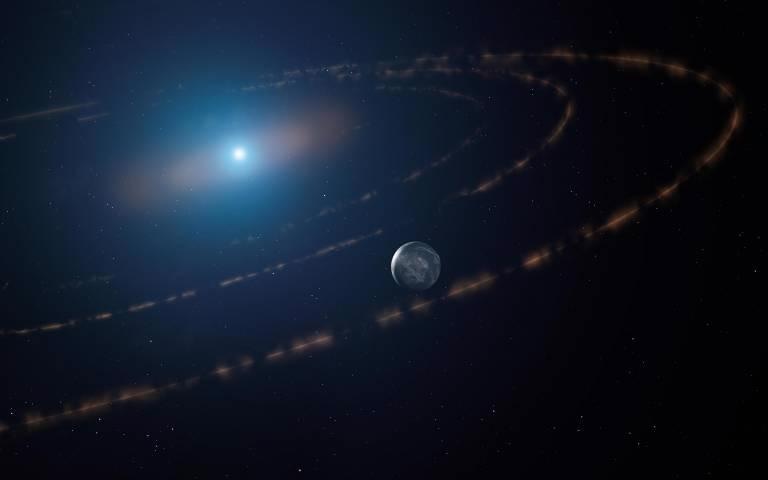According to a new study directed by University College London (UCL) scientists, a ring of planetary debris dotted with moon-sized structures has been noticed orbiting near a white dwarf star, suggesting a planet close by in the “habitable zone” where water and life could be present.
 An artist’s impression of the white dwarf star WD1054–226 orbited by clouds of planetary debris and a major planet in the habitable zone. (Image Credit: Mark A. Garlick / markgarlick.com).
An artist’s impression of the white dwarf star WD1054–226 orbited by clouds of planetary debris and a major planet in the habitable zone. (Image Credit: Mark A. Garlick / markgarlick.com).
Glowing residues of stars that have burned through all of their hydrogen fuel are referred to as white dwarfs. Nearly every star, including the Sun, will ultimately become a white dwarf, but not much is known about their planetary systems.
In the study, published in the journal Monthly Notices of the Royal Astronomical Society, an international group of scientists measured light from a white dwarf in the Milky Way known as WD1054–226, with the help of data from ground- and space-based telescopes.
To their astonishment, they discovered distinct dips in light matching 65 evenly spaced clouds of planetary debris orbiting the star once every 25 hours. The scientists concluded that the specific regularity of the transiting structures — darkening the star’s light every 23 minutes — indicates they are preserved in such a specific arrangement by an adjacent planet.
This is the first time astronomers have detected any kind of planetary body in the habitable zone of a white dwarf. The moon-sized structures we have observed are irregular and dusty (e.g., comet-like) rather than solid, spherical bodies. Their absolute regularity, one passing in front of the star every 23 minutes, is a mystery we cannot currently explain.
Jay Farihi, Study Lead Author and Professor of Physics and Astronomy, University College London
“An exciting possibility is that these bodies are kept in such an evenly-spaced orbital pattern because of the gravitational influence of a nearby planet. Without this influence, friction and collisions would cause the structures to disperse, losing the precise regularity that is observed. A precedent for this ‘shepherding’ is the way the gravitational pull of moons around Neptune and Saturn help to create stable ring structures orbiting these planets,” Farihi continued.
The possibility of a planet in the habitable zone is exciting and also unexpected; we were not looking for this. However, it is important to keep in mind that more evidence is necessary to confirm the presence of a planet. We cannot observe the planet directly so confirmation may come by comparing computer models with further observations of the star and orbiting debris.
Jay Farihi, Study Lead Author and Professor of Physics and Astronomy, University College London
It is anticipated that this orbit found around the white dwarf was swept away during the massive star phase of its life, and therefore any planet that can possibly host water and hence life would be a new development. The area would be livable for no less than two billion years, including around one billion years into the future.
Over 95% of all the stars will ultimately become white dwarfs. The exceptions would be the largest stars that burst and become either neutron stars or black holes.
Since our Sun will become a white dwarf in a few billion years, our study provides a glimpse into the future of our own solar system.
Jay Farihi, Study Lead Author and Professor of Physics and Astronomy, University College London
When stars start depleting hydrogen, they expand and cool, turning into red giants. The Sun will approach this phase in four to five billion years, swallowing Mercury, Venus and perhaps Earth. Once the outer material has lightly blown away and hydrogen is depleted, the hot core of the star stays, gradually cooling over billions of years — this is the white dwarf phase of a star.
Planets orbiting white dwarfs are hard to detect for astronomers as the stars are a lot fainter than main-sequence stars (such as the Sun). Thus far, astronomers have only discovered tentative proof of a gas giant (such as Jupiter) orbiting a white dwarf.
For the new research, scientists watched WD1054–226, a white dwarf 117 light-years away, recording variations in its light spanning 18 nights using the ULTRACAM high-speed camera fitted onto the ESO 3.5m New Technology Telescope (NTT) at the La Silla Observatory in Chile.
To better deduce the variations in light, the scientists also explored data from the NASA Transiting Exoplanet Survey Satellite (TESS), which allowed them to verify the planetary structures had a 25-hour orbit.
They discovered that the light from WD1054–226 was always slightly hidden by massive clouds of orbiting material moving in front of it, indicating a ring of planetary debris orbiting the star.
The habitable zone, occasionally referred to as the Goldilocks zone, is the area where the temperature would hypothetically allow liquid water to be present on a planet’s surface. Compared to a star such as the Sun, a white dwarf’s habitable zone will be smaller and closer to the star as white dwarfs emit less light and thus heat.
The structures seen in the study orbit in an area that would have been enclosed by the star while it was a red giant, so are likely to have developed or arrived fairly recently, instead of surviving from the birth of the star and its planetary system.
Funding for the study was provided by the UK’s Science and Technology Facilities Council (STFC) and involved a team of researchers from six countries, including Boston University, the University of Warwick, Lund University, the University of Cambridge, the University of St Andrews, Wesleyan University, the University of La Laguna, Naresuan University, the University of Sheffield, and the Instituto de Astrofísica de Canarias.
Journal Reference:
Farihi, J., et al. (2022) Relentless and complex transits from a planetesimal debris disc. Monthly Notices of the Royal Astronomical Society. doi.org/10.1093/mnras/stab3475.